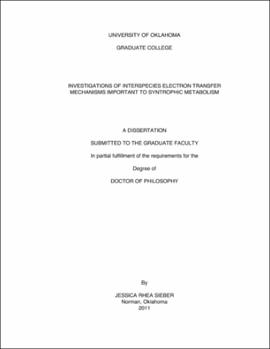| dc.description.abstract | Syntrophy is a tightly coupled mutualistic interaction among microorganisms that is essential for the global cycling of carbon in essentially all anaerobic environments. Syntrophic degradation of aromatic, alicyclic and fatty acids by microorganisms capable of syntrophic metabolism requires a partner organism, usually a methanogen, to maintain extremely low concentrations of H2 and/or formate so that the degradation of the initial substrate is thermodynamically favorable. However, recent evidence that syntrophic ethanol metabolism involves direct electron transfer through nanowires raises doubt about the importance of interspecies hydrogen and/or formate transfer. A combination of genomic, gene expression, and enzymatic analyses along with inhibitor studies were used to test whether syntrophic metabolism by the fatty acid degrader, Syntrophomonas wolfei, and the aromatic and alicyclic acid degrader, Syntrophus aciditrophicus, involves transfer of H2 and/or formate or direct electron transfer. Genomic analysis showed that both S. wolfei and S. aciditrophicus are capable of producing hydrogen and formate as interspecies electron carriers, but lack the pilus and cytochrome system needed for direct electron transfer. S. wolfei has six formate dehydrogenase and three hydrogenase gene clusters. Formate dehydrogenase activity was found to be higher than hydrogenase activity in whole cells of S. wolfei grown syntrophically or axenically. Two hydrogenase genes of S. wolfei were up-regulated during syntrophic growth. S. aciditrophicus contains two hydrogenase and four formate dehydrogenase gene clusters. The genes for all of the major subunits of the hydrogenases and formate dehydrogenases were expressed under all growth conditions. Only fdhII was differentially expressed with a 2-fold higher expression ratio during syntrophic benzoate growth. Hydrogenase activity in S. aciditrophicus was as high, if not higher, than formate dehydrogenase activity, except with cells grown on cyclohexane carboxylate. Inhibitor studies showed the importance of hydrogen transfer for syntrophic butyrate metabolism by S. wolfei, formate transfer for syntrophic benzoate metabolism S. aciditrophicus and hydrogen and formate transfer for syntrophic cyclohexane carboxylate metabolism by S. aciditrophicus. | |
| dc.description.abstract | Analysis of the S. wolfei genome revealed potentially novel types of hydrogenases and formate dehydrogenases, including a unique energy conservation mechanism by confurcation of electrons and many other novel features of the syntrophic lifestyle. S. wolfei contains multiple homologs for the enzymes involved in butyrate metabolism, many of which were detected later in the proteomic analysis. Many possibilities for reverse electron transfer mechanisms including a novel iron-sulfur oxidoreductase, an electron transfer flavoprotein:quinone oxidoreductase, and a bifurcating butyryl-CoA dehydrogenase were discovered in the genome and latter detected in the proteome of S. wolfei. This research shed light on the metabolic machinery involved in reverse electron transfer, which is essential for syntrophic metabolism. The research also showed that the importance of H2 versus formate transfer depends on the substrate and organism involved and that S. wolfei expresses multiple enzyme systems for fatty acid metabolism, interspecies electron transfer, and energy conservation. | |
